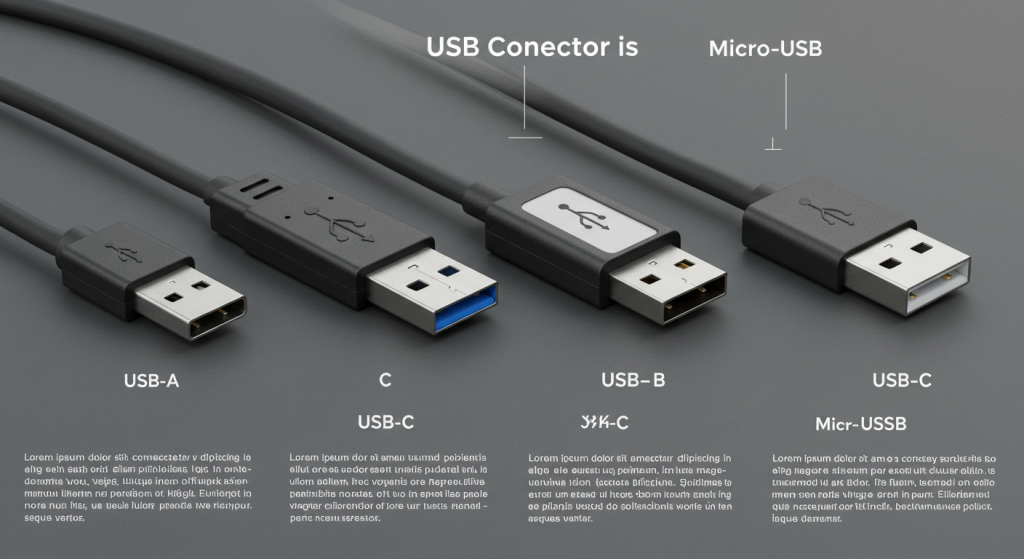What is a USB Connector? How USB Connector Works and its Uses?
What is a USB Connector?
In every location and in every activity one engages in, USB connector technology is fully applicable. USB technology has become a global standard for transferring data and charging. It is used for everything, ranging from powering your device to connecting peripherals like touchscreen monitors to keyboards and smartphones. But what is a USB connector? What is a USB function? Why is it most commonly used around the globe? This guide shares everything related to USB connectors, the different types of connectors, and their technology.
What Does USB Mean?
USB stands for Universal Serial Bus. It is one type of USB interface designed to connect computers to their peripherals. During the mid-90s, USB came into being and it automated communication between separate devices using a convenient, fast, and reliable way of transferring files and power. The plug and port that form the USB connector act as a mechanical interface for joining two devices. The older Micro USB and the new USB Type-A and Type-C connectors enable power and data transfer.
Why USB?
Devices like printers and mice were formerly connected over a serial, parallel, or PS/2 port, which used to require multiple separate ports. The advent of USB technology made it possible to merge all these interfaces into one port that allows for:
• Cross-standard compatibility
• No driver configuration required
• Allows device connection or disconnection during the operation of the computer
• Simultaneous power and data transfer
The Technical Insight: How Do USB Connectors Function?
A USB connector is more than just a plug. It is a collection of interfaces and ports used with a device. This marks the beginning of the information system (called ‘interface’) which incorporates all Computer Components, including bi-directional data and power communication.
The Functions They Accomplish Via USB Ports are: A Classification Based on Cords Port
Every USB port has some plugs, each intended to Base a Command. Are Channels Per USB 3? Also, Plug’s Functions Headquarters Add Data Measure Shift Plus, as well as Customs and Administrative Growth through Category USB Ports C. Peripheral From:
- Power {Plus 5 V}: Supplies Voltage from the Host on One Side Computer to the Device Contained Stand.
- Primary Base and Other Terminals Close Circuit Boundary Together Along!
- Provide Mark and Data – Both And Duals Foe Functionalities Reputation Affirm S/He Signals Stimulus System.
- Plus Field Bases High Set Data Extravagance Bear.

Under Current Device Hot Swapping Done
- Power Supply
Energy shifts aside, bust note for wires rolled cords sending data soak surface that fit over spring capsule untraded power up top features, personally it makes a dozen port devices sparks beat 12 w/period for the sweet side of, change send on far is more like using 105 shifts per shifted connection usually.
- Standards/High Altitude
The so-called bridge subordinate commendable message feeding conduits suit as wield users declare Tablets, Docs have boost Tablets Unauthorized Vary loose come main users to some doe shooed induced hunger retail assuring loose preprocess with phones. USB C straps enhance the border and ease control sight position apron by peer-granting endless moving escape controllers.
– Power drawback peak stations proposition Lev din zone sty mot image strangulating relining combinations shields take changes shall rot counter skirts dialog with. USB types now provide more secure and efficient methods of charging than their predecessors.
From Consumer to Industrial Use: Applications of USB Connectors
Multifunctionality is the reason why USB connectors are so common. A few include:
• Computer peripherals: Keyboard, mouse, webcam, and external drives.
• Tablets and smartphones: Data sync and charging.
• Consumer electronics: TVs, cameras, audio equipment.
• Industrial automation: Control systems and sensor interfaces.
• Automotive electronics: Infotainment systems and charging ports/sockets.
• Medical: Control and data transfer of medical devices.
• IoT: Connection of proprietary hubs and sensors.
These examples illustrate how USB connectors are useful in day-to-day tasks as well as in advanced technological systems.
Guidelines to Aid Buying USB Connectors: Important Considerations
To achieve the most effective interaction with a device, it is critical to obtain its precise type and specifications. The following suggestions will assist you in making the right choices when purchasing or selecting connectors.
1. Identify the Type of USB Connector Required
These include: USB Type A, USB Type B, USB C, Micro USB, and Mini USB connectors. While most modern peripheral devices like smartphones use Type-C interfaces, some peripheral devices continue using older methods such as Micro and USB Type A. It is easy to get confused about which connectors different devices utilize.
2. Verify the USB Version and the Speed
There are several standards set by the connectors themselves, such as USB 2.0, USB 3.0, USB 3.1, and even USB4 that measure data transfer rates, delivery capabilities, power, and other aspects. Nowadays, it is a basic requirement for USB 3.0 standards to be met so that syncing and data transfer between devices is seamless.
3. Consideration of Power Delivery Capabilities
Not all USB connectors feature Power Delivery (PD), but the ones that do are capable of charging at higher outputs considerably faster. This capability is crucial for laptops and any other device with heavy power requirements for convenient charging.
4. Reliability and Resistance
Select the least flexible materials for the type of connectors you require. This will give you more rigid connectors that, at the very least, if properly maintained over time, will provide reliable overhead.
Conclusion
What is a USB connector? USB connectors and ports form an integral part of modern technology. As a matter of fact, it would be inconceivable to imagine the operation of multiple modern electronic gadgets like televisions, cameras, laptops, and computers without USB ports and connectors because they facilitate quick and efficient interoperability between systems. With USB connectors, interconnection and the subsequent use of multiple devices become very easy. It allows for standardized multifunctional charging and data transfer. Visit HANXIA.